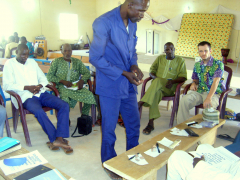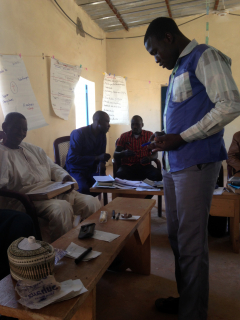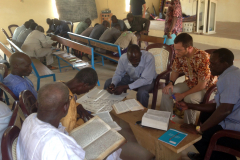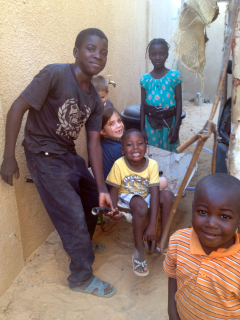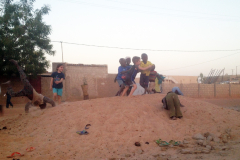A letter from Michael Ludwig serving in Niger
May 2017
Write to Michael Ludwig
Write to Rachel Ludwig
Individuals: Give online to E200513 for Michael and Rachel Ludwig’s sending and support
Congregations: Give to D507575 for Michael and Rachel Ludwig’s sending and support
Churches are asked to send donations through your congregation’s normal receiving site (this is usually your presbytery).
“But if you ask people, ‘what are your problems?’ they’ll immediately expect you’re going to come in and fix the problems for them,” said Attahiru. Attahiru is from a frontier village of 300, where he’s not only a lay pastor, but a major leader for the youth. Facing village expectations of handouts was the number one concern of pastors at our review session for Community Health Evangelism (CHE). The previous week, I’d accompanied the CHE national trainer of our partner, the Evangelical Church in the Republic of Niger (EERN), as we organized the first CHE training in the church’s second largest region. With 25 pastors and evangelists in a sweltering church building, we role-played, laughed about, prayed-over, discussed and learned all things CHE.
A week later, we were back to review with four pastors we had selected to mentor as they implement the CHE method in their communities. The problem of a “dependency mentality,” which Attahiru summed up so well, still stared us in the face. We reviewed how that’s precisely why he won’t start by asking about problems as he shares with the village elders and other neighbors. Instead, the CHE evangelists start their sharing by telling a few stories of people needing help to cross a river and a neighbor helping a man who fell on a road. These stories give a glimpse of how outside help can never fix the whole problem and how people must work together with the right attitude to accomplish something for themselves and their communities. If the evangelists can get their groups talking about the meaning of these stories and agreeing with the wisdom they see within them, these types of stories start the community thinking about why it’s necessary to use what they know to address their community’s problems themselves. With this proactive mindset, the group can then go on to look for their biggest problems.
The issue Attahiru raised also highlights another part of the CHE teaching method. With CHE, people are taught to think of large problems as “trunks” of trees. Once people can see the trunk of the tree, we talk about the branches and fruit that come out of this trunk. We can see all sorts of specific problems that result in unwanted “branches.” Then we look for the roots of this trunk and consider how much better it is to work on cutting out the roots of this problem than to wrestle with the branches. If the big problem is a trunk of “dependency on outside aid,” with branches that range from letting wells fall into disrepair, neglecting to practice sustainable farming and lacking realistic financial planning, then what are the roots we need to be cutting? One of the biggest roots is outside gifts that are not sustainable or repeatable. Consequently, the focus of CHE is to help communities see the problems that are the right size for their village to tackle without outside gifts. Then communities are empowered to use their own materials and efforts to fix the problems, which continues to build their capacity to address other problems (with the input of education and encouragement).
Looking at the roots that the CHE method uncovers leads us to another question: “What can we as people from the outside do to help communities work on their own problems?” The large answer is to pray for them and build relationships with them that focus on developing leaders. We can continue by giving gifts that empower people to multiply them and encouraging them by valuing their own skills and resources. These are not always easy, immediate, or efficient ways of helping that have clear actions. But that’s why we’re working together to build bridges so we can have connections between the EERN and the PC(USA), relationships that can grow, flex and make it possible for us to discover together what we can share to help each other.
Fortunately, the next steps are clearer for our four CHE evangelists. As an evangelist begins using CHE in his community, he tells the chief about this plan for self-development and preventing health problems. He follows this with “prayer walking,” finding “people of peace” and then telling them that he would like to come and share stories about improving the health of the community. The evangelist continues coming back to these individuals or groups to share stories and talk about what people find important in the stories. Eventually, these discussions spur people on to decide to do something about their problems. The national trainer and I also visit the evangelists to give encouragement, to provide extra lessons they can use with their families and groups with whom they meet and to learn together what works best for their situation.
In our family, we continue to press deeper into our own neighboring community, as well. We’ve found it’s tough to find a sweet spot between engaging our neighbors like we’re just any other member of the community and retaining some of our Western independence and comforts that keep us from mentally wearing out. We’ve made progress by practicing more reciprocity in giving food at holidays, helping to bandage an assortment of neighbors’ wounds and learning other cultural traditions. While our children have long been intimidated by the neighbor kids’ rough playing style, lately they’ve developed more interest in playing together on construction sandpiles. There’s even a girl who is engaging in more calm, relational play with our daughter. We do feel that we’re finding ways to be influential and to be a resource here without being a go-to, quick fix for anyone and without being resented outsiders.
In the months that follow, we ask for your prayers for the strength and wisdom to continue supporting our EERN partners and participating in our community. Pray also for Pastor Issa, the CHE national trainer with whom I’m working. He has a big job of visiting, furthering training and reporting on the church’s CHE plan. We hope soon to be able to share more about the rickshaw taxis that supporters have donated to help the church provide ongoing funding for the plan.
The recent CHE training had a reoccurring theme: that we aspire to be like the faithful stewards from Matthew 25 who multiply what they receive and are given even more to work with. We couldn’t strive for this without your financial, emotional and spiritual support, so we thank you and invite you to continue to be involved with the root causes and root solutions that can be found through strengthening our relationships across the body of Christ.
Michael and Rachel Ludwig
![]() You may freely reuse and distribute this article in its entirety for non-commercial purposes in any medium. Please include author attribution, photography credits, and a link to the original article. This work is licensed under a Creative Commons Attribution-NonCommercial-NoDeratives 4.0 International License.
You may freely reuse and distribute this article in its entirety for non-commercial purposes in any medium. Please include author attribution, photography credits, and a link to the original article. This work is licensed under a Creative Commons Attribution-NonCommercial-NoDeratives 4.0 International License.
